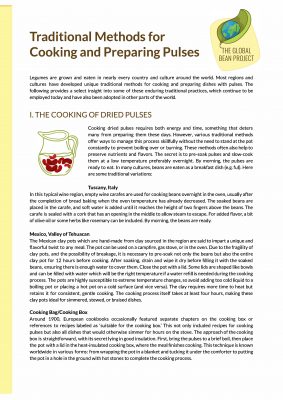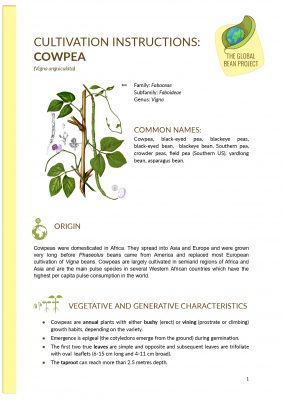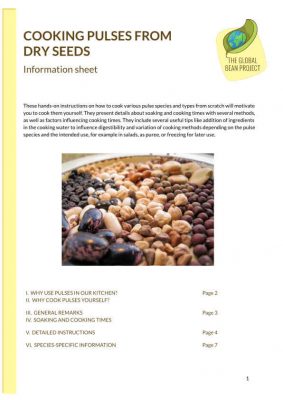These instructions on how to cook various types of dry pulses will show you just how easy it really is. With details about soaking and cooking times using several different methods, you’ll soon master the art of cooking tasty pulse dishes from scratch. While the process may seem daunting at first, there are a number of tricks that you can utilise to bring more dried pulses into your kitchen.
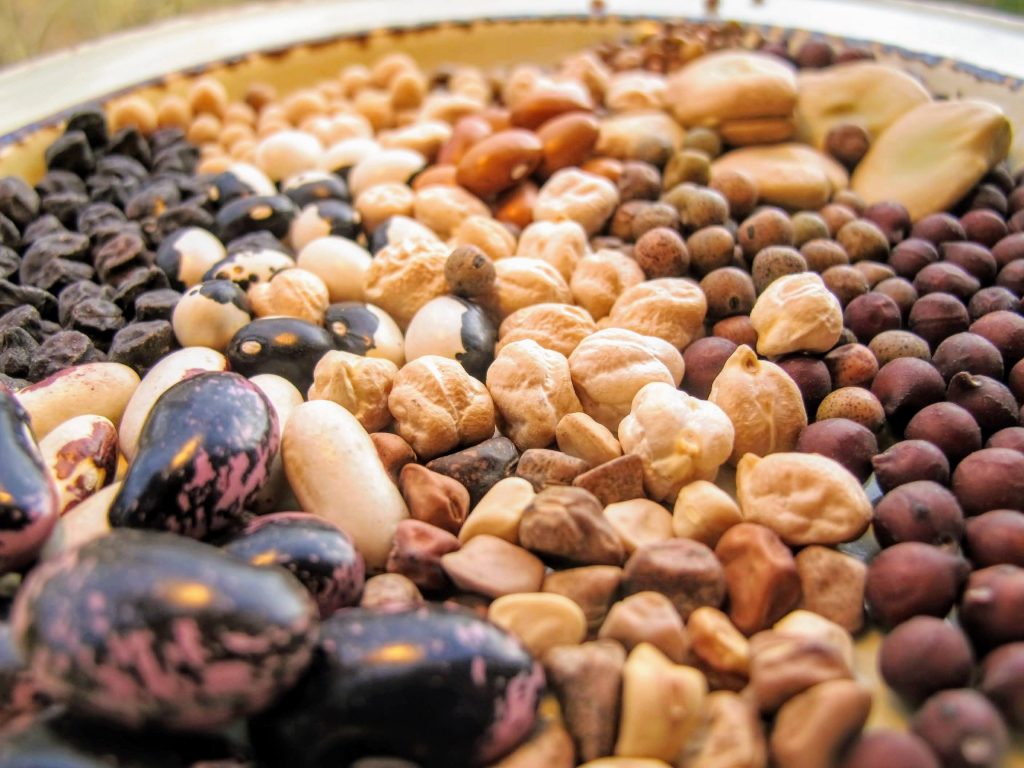
I. WHY USE PULSES IN OUR KITCHEN?
Pulses are the dry seeds from the following leguminous plants: lentils, peas, chickpeas, beans, fava beans.
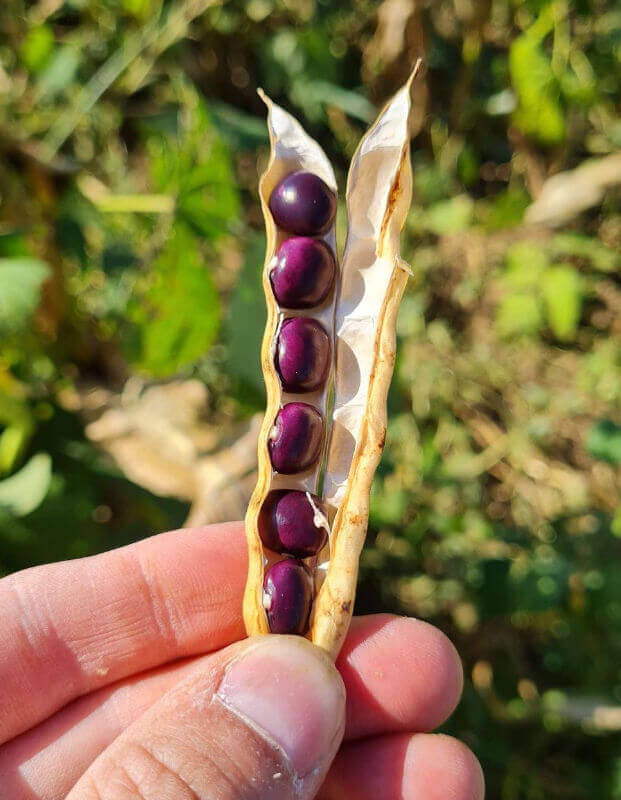
Fresh, young beans or peas are vegetables and are only available during the harvest time. However, pulses are harvested and stored dry and are therefore available throughout the year. Cooking dry pulses is easy and provides a nutritious basis for a healthy meal. Since they are high in protein and dietary fibre, low in fat and contain vitamins and minerals, they can be a good alternative to animal products in your diet.
Beans, peas, chickpeas and lentils come in a huge diversity of colours, shapes and sizes, textures and flavours. Apart from a few exceptions like crunchy pulse snacks and falafel-like preparations, pulses always need to be cooked in water.
To prepare a quick meal using pulses…
You can buy common cooked pulses ready to use in tins, in glass jars and other containers. We then recommend you buy local organic pulses in glass when available, since they are usually better for you and the environment. More unusual cooked pulses are only available from specialist shops.
However, cooking pulses yourself provides several advantages.
II. WHY COOK PULSES YOURSELF?
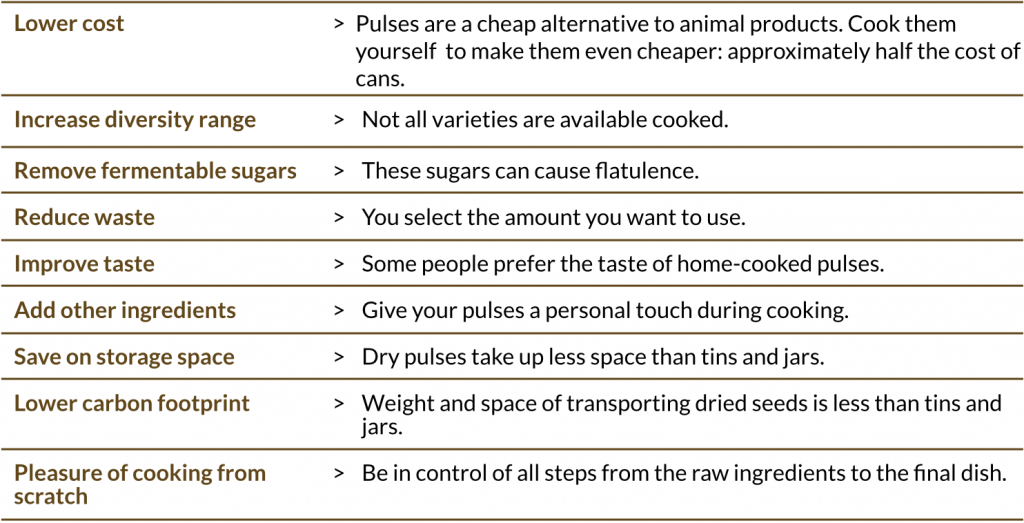
With a little bit of planning and following our tips,
you will be able to cook these delicious and versatile seeds yourself!
III. GENERAL REMARKS
Here are a few useful explanations about pulses for those new to cooking them.
Split versus whole pulses
Peeling or dehulling removes the skin. Often the cotyledons are separated, that is, the seeds are split in two.
Lentils, peas and fava beans are relatively easy to find in their dehulled, split form. Split or peeled chickpeas are also available but you might need to look around more to find them. Using split pulses has a couple of advantages:
- reduced cooking time, more digestible
- quickly turn into purée during cook
Note: only for dishes not requiring pulses to remain whole. Ideal for dal, purees, spreads or to thicken a creamy soup, not recommended for salads.
Getting your body used to pulses
Adding some ingredients while cooking relieve flatulence. (see “optional ingredients”)
If you are starting to eat (more) pulses, you may want to let your body get used to the fibre-rich seeds. One suggestion is to start with smaller quantities and with dehulled pulses (red or yellow lentils, split peas, dehulled fava beans).
Batch-cooking pulses for later use
Defrosted pulses taste as good as freshly cooked!
Consider soaking and cooking more pulses than you need for one recipe. You can store the excess in the fridge or frozen for later use (see section 4. After cooking).
IV. SOAKING AND COOKING TIMES
The three methods are described below. ‘Traditional’ cooking refers to pulses that have been soaked with a pinch of bicarbonate and that are cooked by simmering in a normal saucepan. If starting from dry, non-soaked pulses, the cooking time will be 1.2 to 2 times longer.
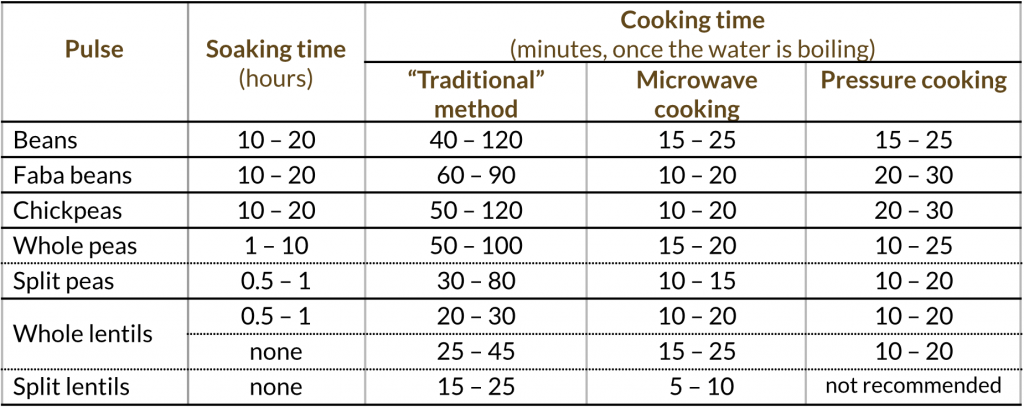
V. DETAILED INSTRUCTIONS
The following instructions take you step by step for preparing, soaking and cooking the pulses.
1. Preparing your dry pulses
Before even starting with soaking or cooking, wash the seeds with running water in a sieve or in a big bowl (this is preferable, so you can remove any floating object like plant parts or bad seeds). Be aware that in rare cases there can also be stones, so do your best to remove them as well.
2. Soaking: not indispensable, but highly recommended
Soaking pulses in water for 1 to 24 hours “wakes up” the living seeds and starts their germination process, which reduces the cooking time, releases several anti-nutritional compounds in the water and reduces the amount of the compounds responsible for the production of gas during digestion.
Don’t worry if you forgot to weigh them before soaking: pulses soaked 10 to 12 hours weigh approximately double their dry weight.
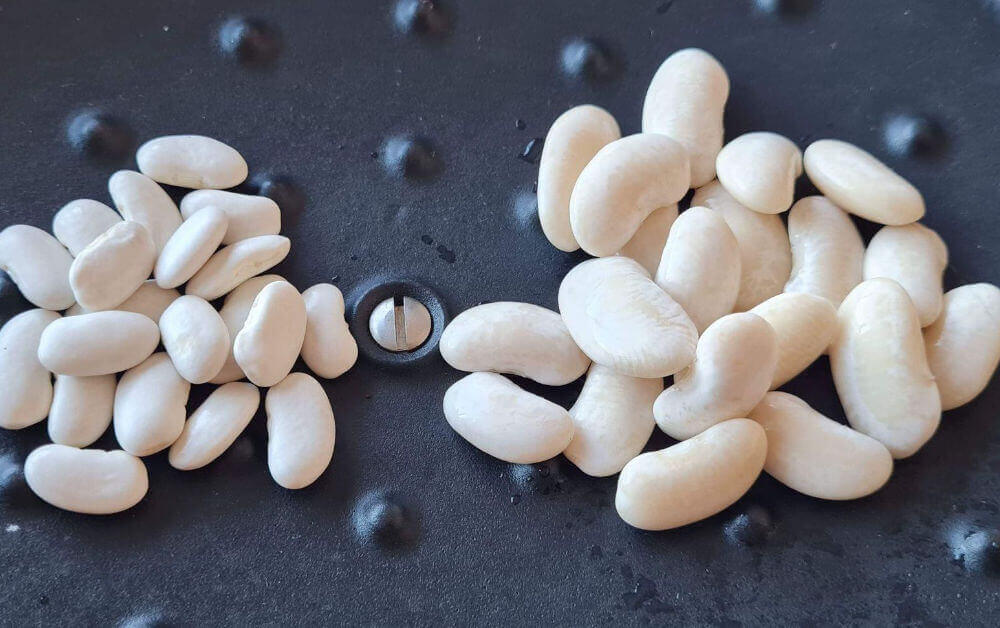
- Place the pulses in a big salad bowl or a saucepan and add water to cover them. The seeds will increase to double or triple their size: make sure you add enough water, so that they are all covered during the whole process.
- Optional: Use of around 1 gram of bicarbonate for 100 g dry pulses creates a slightly alkaline environment, which helps the water to go through the skin of the seeds. This is especially useful when using hard water.
- Leave them 4 to 24 hours. In hot weather conditions, soaking time should be reduced, or find a cool place to soak the pulses (in the fridge is a possibility).
- Optional: changing soaking water one or two times during the process can increase the benefits of soaking.
- Rinse the pulses after soaking, before cooking, and never use the soaking water for cooking!
Chickpeas need a heat shock when they start cooking!
Fast Soaking
If you are short of time, here is how you can reduce soaking time to one hour:
- Place the pulses in a saucepan and cover with cold water, except chickpeas that need to be placed directly in boiling water.
- Bring the pulses to the boil for a few seconds. For chickpeas, simmer for 2-3 minutes.
- Remove the cooking or saucepan from the cooker.
- Leave for one to three hours with a lid on.
- Discard the fast-soaking water, rinse and use new water to cook.
3. Cooking
Bicarbonate lowers the pH of hard water to create a slightly alkaline environment.
Boiling temperature is lower at high altitudes.
Pulses cook faster when:
- Water has a pH between 7 and 8.5 (avoid hard water!)
- They have been harvested in the last two years.
- They have been stored in cool, dry conditions and consistent temperature.
- They are cooked at a low altitude.
Always cook pulses until they are soft!
Except if you plan to add them to a soup or a stew where they will keep cooking, cooked pulses should be soft enough to be mashed when pushed between two fingers and not be “al dente” when you taste them. Undercooked pulses are always more difficult to digest than well-cooked ones. Allowing the pulses to rest in the warm cooking water after cooking gives additional hydration and softness.
Unlike the other pulses, chickpeas need to be put directly in boiling water.
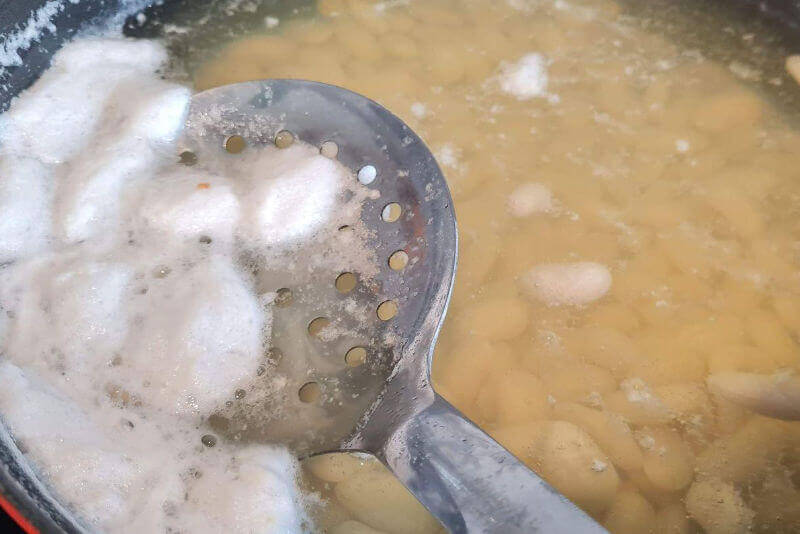
Cooking method #1: ‘Traditional’ cooking
- Place the pulses in a big saucepan, which has a lid, and cover with cold water, except chickpeas (see side note). The ideal cooking water volume varies from 2 to 6 times that of the pulses (see specific per species instructions in section VI.)
- Allow the pulses to boil without a lid to avoid boiling over. When it starts to boil, reduce the heat, cover with a lid, and let it simmer gently.
- Remove the foam (or froth) that sometimes forms during the first 10 minutes, using a skimmer.
- Check softness and remove from the heat when done.
Cooking method #2: Pressure cooking
Thanks to the higher temperature when using a pressure cooker (120C° versus 100°C), cooking time can be reduced approximately by half. Once the water is boiling, reduce the heat to the minimum required to maintain the high pressure. Be careful: never fill the cooker to more than 2⁄3 and always check that the pressure has gone down before opening! If you’re not sure, follow the manufacturer’s instructions.
Cooking method #3: Microwave cooking
Place drained, soaked pulses in a container with 2 times the volume of fresh hot water, cover and cook at 800 W or full power for 8-10 minutes or until boiling. Reduce power to 460 W or 50% and cook for another 10-20 minutes or until pulses are tender. See cooking times in the table.
Cooking method #4: Baking
Some recipes involve baking pulses in the oven. It is a way to create a glazed, crusty top on your pulse dish, like in the original baked beans and bean pot casseroles. This should be done with pulses that have first been (under)cooked with another method, for minimum 50% of the normal cooking time, depending on the baking time and the humidity of the sauce. However, pulses can be cooked very nicely in the oven, using an oven-proof pot with the lid on.
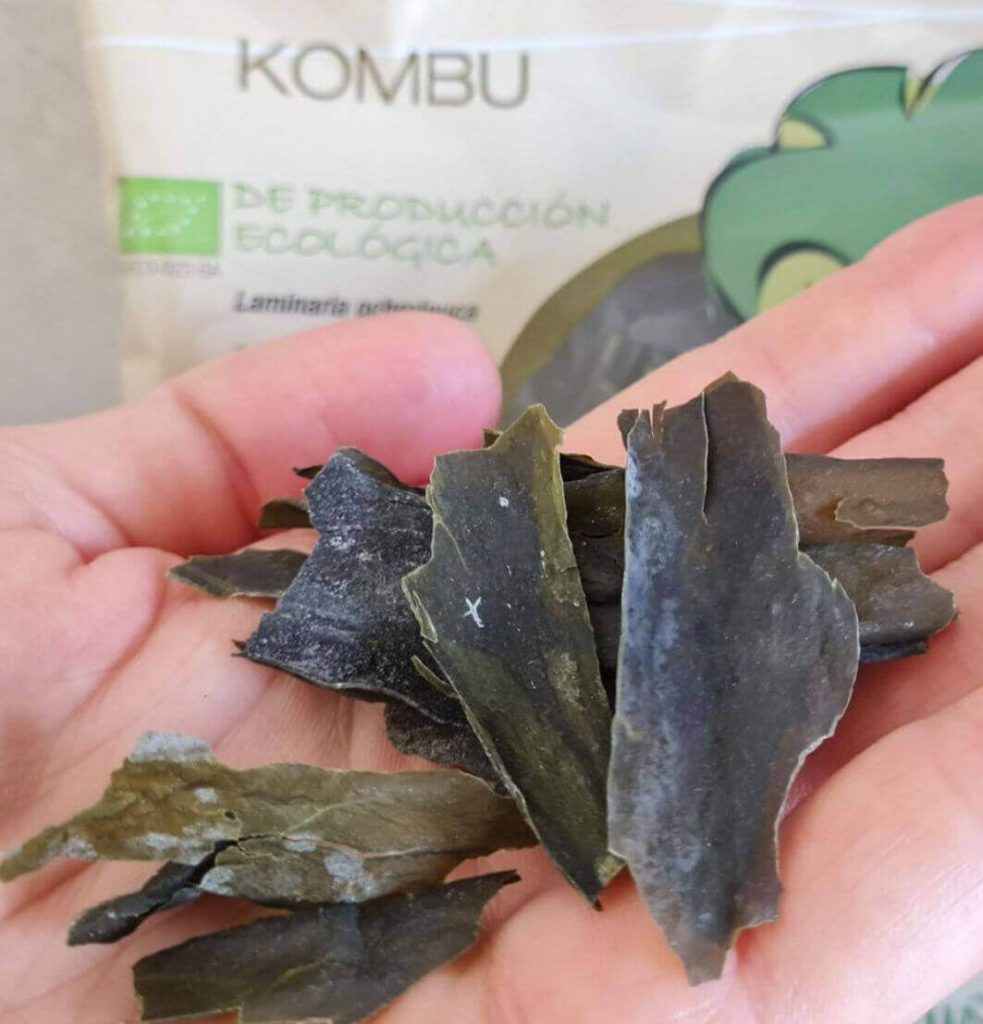
Further cooking tips: Optional ingredients
Optional: Bicarbonate can reduce cooking time. However, when cooking, avoid using more than 1 gram per 200 g pulses, since it may destroy the texture of the pulses and result in a soapy taste.
Optional: Addition of carminative herbs and spices in cooking water relieve gas formation and increase digestibility (dill, fennel, anise, savory, cumin, cardamom, coriander, star anise, ginger). Adding a piece of kombu (a seaweed) in the cooking water also improves digestibility.
Use of salt: there is a difference of opinion here! Some state that salt makes the cooking process longer, some others say that it makes no difference. Generally:
- If you want to avoid the skins of your pulses to burst when cooking, add a pinch of salt at the start of cooking.
- Otherwise, add salt to the pulses in the last 10 minutes of cooking or right after draining, when they are still warm.
Cooking pulses together with other ingredients like vegetables or cereals is possible.
4. After cooking
Cooked pulses weigh two to three times more than their dry weight.
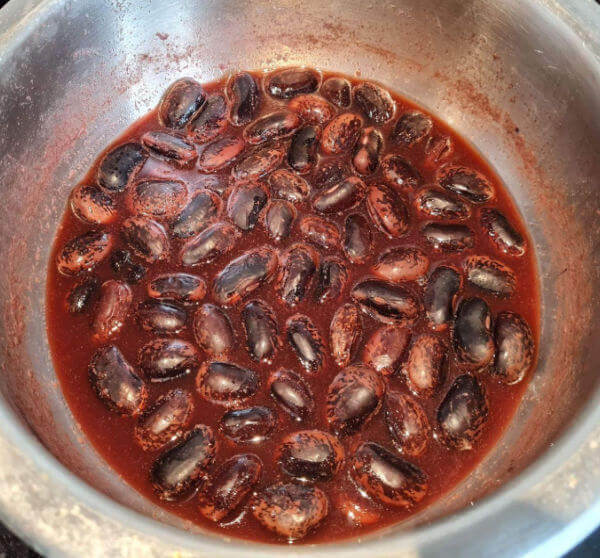
If you want to use the cooked pulses directly, drain the cooking water. Otherwise, let them cool in their cooking liquid, store them in the fridge in their cooking liquid for up to 4 days, or freeze them with their cooking liquid in airtight bags or containers. They can be kept frozen without a problem for up to 3 months, after that, texture and taste may be affected. Defreeze them slowly, that is to say, start by leaving them a few hours in the fridge at first. Defrost pulses will be just as good and versatile as freshly cooked!
Overcooked pulses, especially beans, tend to fall apart, releasing starch, which thickens the cooking liquid. This may be desirable for some recipes.
The cooking water contains antinutritional factors but some cooks use it as a “consommé” (broth). Aquafaba is the cooking water of chickpeas and has properties similar to egg white.
A chef’s tip for delicious pulse-based salads: add the dressing (in most cases salt, vinegar and oil, why not some spices and something sweet?) directly after draining the cooked pulses and stir when they are still warm. The taste will go to the core of the seeds!
Ready to enjoy!
You can use your home-cooked pulses in all kinds of recipes: stews and soups, burger patties, dips and fresh salads, not forgetting sweet treats like spreads, cakes and cookies!
VI. SPECIES-SPECIFIC INFORMATION
Beans (Phaseolus communis and Phaseolus coccineus)
- Always start cooking beans in cold water.
- Use relatively little water: a ratio of 1:2 or 1:3 (volume of pulses : volume of water) is ideal.
- Cooking time is highly dependent on the abovementioned factors, but also depends on the variety. There is a huge diversity within dry beans.
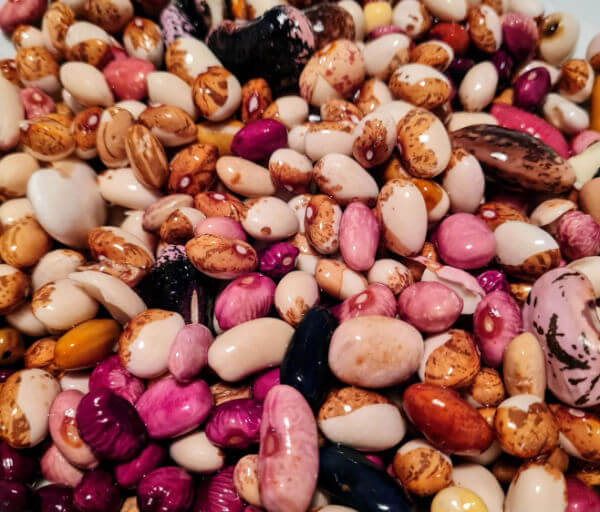
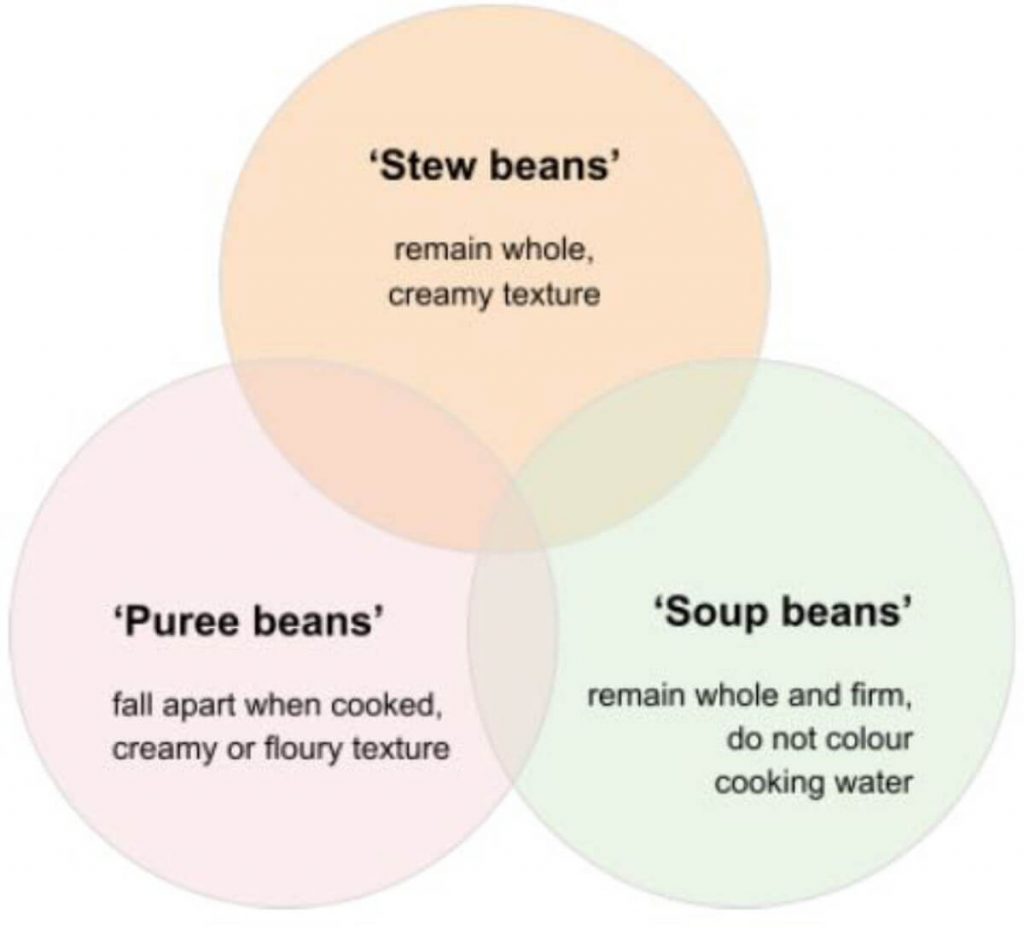
It is possible to roughly group them in three overlapping categories of cooking properties and texture (see scheme).
Kidney beans are typical stew beans, the heirloom bean varieties ‘à Goût de Châtaigne d’Échenans’ and ‘Wildtäler’ are typical puree beans, Great Northern beans are typical soup beans.
In case you do not know which category your bean variety is in, information about the texture can be found on the internet for most common varieties.
If you want the beans to stay whole (for instance for a salad): avoid ‘puree bean’ varieties, avoid using bicarbonate and add salt when soaking and cooking. A further method you may want to try that helps keep them whole: add water at room temperature when the saucepan starts boiling, twice or three times. In Spanish, this is called “asustar” (frightening), probably because they suddenly stop moving when you pour tempered water, just like frightened animals.
For coloured beans, you may want to use as little water as possible, adding water little by little, when needed. This maintains some of the colour.
Fava beans / faba beans / broad beans (Vicia faba)
- Start cooking fava beans in cold water.
- A ratio of 1:3 (volume of pulses : volume of water) is ideal.
- There is a large range of seed size, bigger beans generally have a thicker skin and longer cooking time. Remember that we are talking about dry fava beans, fresh broad beans are cooked in a very different way!
- Split fava beans: see note in “General Remarks”
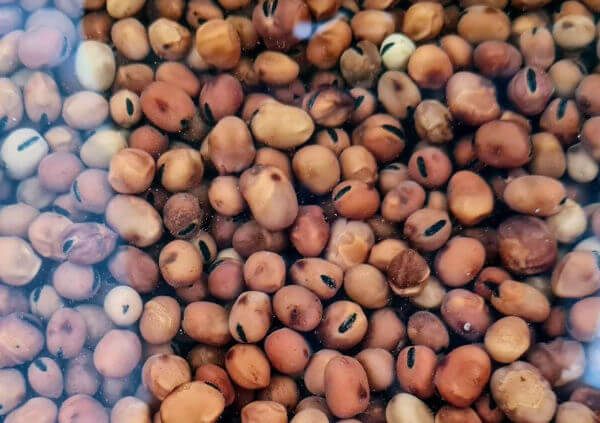
Chickpeas (Cicer arietinum)
- Always start cooking chickpeas in hot water: add chickpeas to water that is already boiling, otherwise they will not get tender.
- Use a large amount of water: a ratio of 1:6 (volume of pulses : volume of water) is ideal.
- There is a large range of seed size and colour, so there are varietal differences in cooking time, taste and texture.
- Split chickpeas: see note in “General Remarks”
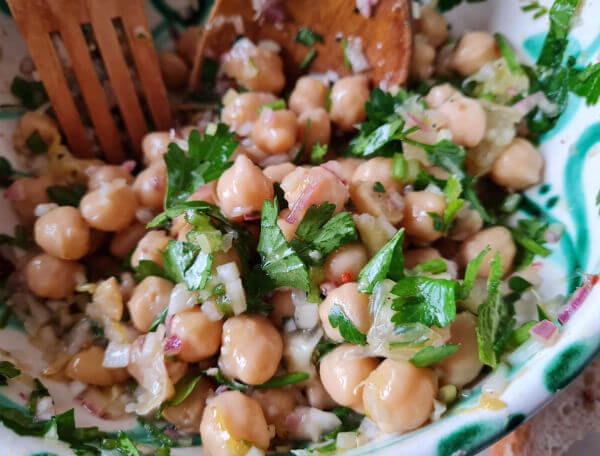
Peas (Pisum sativum)
- Start cooking peas in cold water.
- A ratio of 1:4 (volume of pulses : volume of water) is ideal, but use less in case you cook split peas for a thick purée.
- There is a lot of diversity within peas, from big yellow peas to wrinkled green peas that turn mushy, to big and small grey peas which may or may not stay whole when cooked. Remember that we are talking about dry peas, fresh green peas are cooked in a very different way!
- Split peas: see note in “General Remarks”
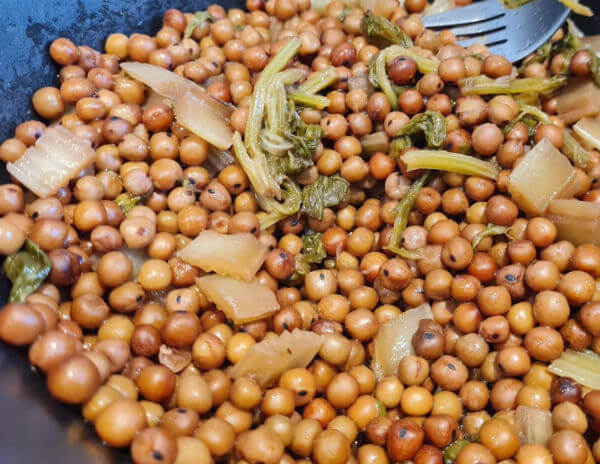
Lentils (Lens culinaris)
- Soaking is not required but soaking up to two hours reduces the cooking time. Start cooking lentils in cold water.
- A ratio of 1:3 (volume of pulses : volume of water) is ideal, but use less in case you cook split lentils for a thick purée.
- Lentil varieties have different cooking times and textures. In general, the small relatively spheric lentils (e.g. green ‘Puy-type’, black “Beluga”) tend to cook longer and hold their shape better than the flat beige lentils, which often tend to get mushy, like split lentils.
- Split lentils: see note in “General Remarks”
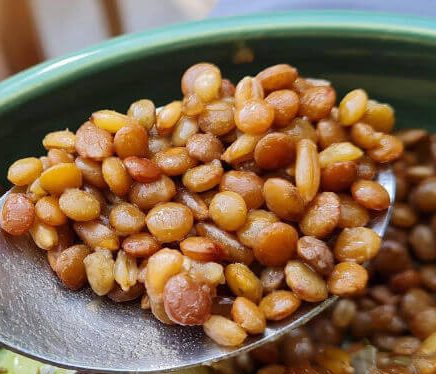
References
Indications based on our own experience and the following books, websites and articles:
- Book ‘La cocina de las legumbres‘ by Fundación Alícia (2016),
- Book ‘Savez-vous goûter … les légumes secs’ by Bruno Couderc, Gilles Daveau, Danièle Mischlich and Caroline Rio (2014)
- LegumeChef: How to Prepare Pulses for Cooking?
- Scientific publication about the environmental impact of canned vs. home-cooked pulses
This work is licensed under a Creative Commons Attribution-NonCommercial-NoDerivs 3.0 Unported License.
All pictures © 2021-2022 Nicolas Carton


